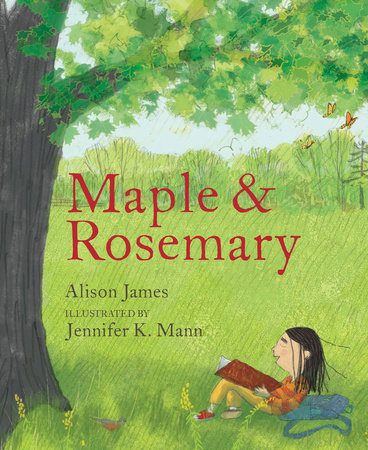Maple & Rosemary


Maple & Rosemary
illustrations by Jennifer K. Mann
Published by Neal Porter Books, Holiday House
For the longest time, Maple was on her own, ignored by the cedars and the pines. All she wanted was a friend she could talk to. Then one day, Rosemary climbs into her branches, sad and searching for a friend of her own. Together they form a bond as real as roots.
Through the seasons and across a lifetime, Maple and Rosemary tells a story of true friendship, one in which the experiences we share become a part of who we are. Alison James’s spare, eloquent text is accompanied by luminous illustrations that capture the shifting seasons in all their glory, by Jennifer K. Mann, creator of the much-acclaimed picture book, The Camping Trip.
reviews
Starred "Big Picture" review from the Bulletin for the Center for the Study of Children's Books (BCCB)
Maple & Rosemary Written by Alison James and illus. by Jennifer K. Mann
Shel Silverstein’s The Giving Tree is a beloved childhood classic, but its allegory of boundless parental sacrifice has not aged especially well and has prompted a number of parodies and revisions, such as Topher Payne’s The Tree Who Set Healthy Boundaries. While this month’s Big Picture, Maple & Rosemary, doesn’t explicitly reference The Giving Tree, it, too, feels like an update to the classic—rich, warm, and bittersweet in contrast to Payne’s pointed satire, with a wisdom that will speak to both young readers and their caretakers. Maple is a sugar maple, “lovely and sweet” but lonely, as she’s the only deciduous tree in a stand of cedar and pine, and the evergreens aren’t interested in getting to know a tree that sheds its leaves. When little Rosemary climbs Maple’s branches to cry because the other children at school are mean to her, both girl and tree find the friendship they’ve been yearning for. Rosemary shares her troubles and school lessons in the shelter of Maple’s leaves, and Maple shows Rosemary the lifecycle of butterflies and rains seeds down around her. Rosemary inevitably grows up and stops visiting, leaving a desolate Maple wishing for “the winter to cover her with snow and never ever melt.” The book lingers here, with minimal text as seasons pass, visually immersing readers into the forest setting and its quiet solitude, as more treessprout and various animals come and go. Rosemary’s eventual return as a young woman is greeted with warmth and then glee as she reveals a gift to Maple, hanging a wooden swing from Maple’s branches. She’s a teacher now, and soon she brings the children from her class to play, giggling on the swing and delighting Maple. When that, too, ends, an elderly Rosemary visits alone to read to Maple, and Maple drops a branch for her to use as a walking stick. “You have always been here for me,” Rosemary says, and Maple understands Rosemary is part of her, too, “as real as roots.” James’ gentle, straightforward prose is striking in its simplicity, capturing the strangeness and joy of new friendship as well as the ache of loneliness. During Rosemary’s long absence, “year after year, winter swept into summer. Leaves bloomed, burned, then fell.” The quiet tone invites contemplation of the power of friendship, making space for complexity as Maple and Rosemary each grow in each other’s absence and find an even more profound connection in their later years. It’s a thoughtful portrayal that honors the way relationships change over time; where Rosemary goes to Maple for comfort as a child, she in turns offers the tree care as an adult, and neither is diminished in service to the other. Mann’s sweeping, digitally collaged landscapes glow in a warm welcome to young viewers, with a combination of painterly and penciled textures bringing depth. There is a sense of motion in Maple’s leaves and the grass that surrounds her, as if rustling on a gentle breeze, while Rosemary’s simple, childlike figure is more kinetic, leaping, climbing, and playing in montage-like scenes that capture the energy of their daily time together. Mann uses color and image repetition skillfully, with the dominant green-gold palettes of summer contrasted by both the fiery autumn hues and the white and brown stillness of winter. Each image centers Maple, sometimes alone, sometimes surrounded by children, as the seasons change around her. Rosemary stands out in clothes that match the crimson, red-orange, and dusty yellow of Maple’s autumn leaves, emphasizing her vibrancy but also subtly suggesting the impermanence of all living things. Adult readers will anticipate Rosemary’s death from the winter setting of the friends’ final scene, but the book only implies it, focusing instead in its final pages on Maple as she contemplates their friendship: “She spread her leaves to the sky and remembered . . . Now Maple knew what it meant to have a true friend. No matter where you are, you are always together.” It’s a moment that feels piercing, beautiful, and true as it honors the depth and longevity of friendship, even with the inevitability of loss. —Sarah Sahn, Reviewer |

